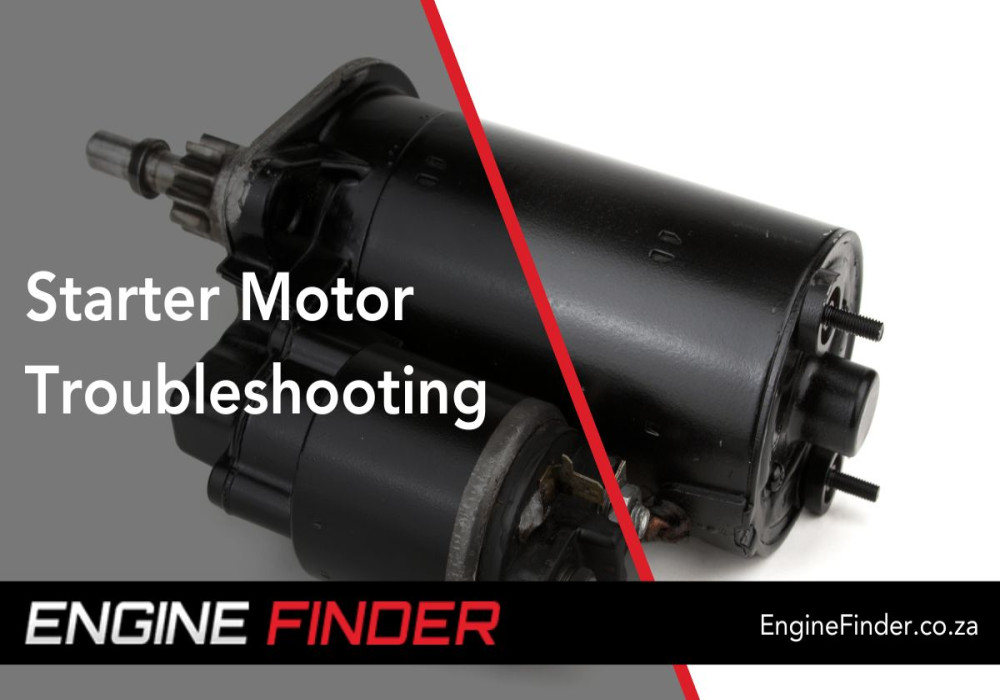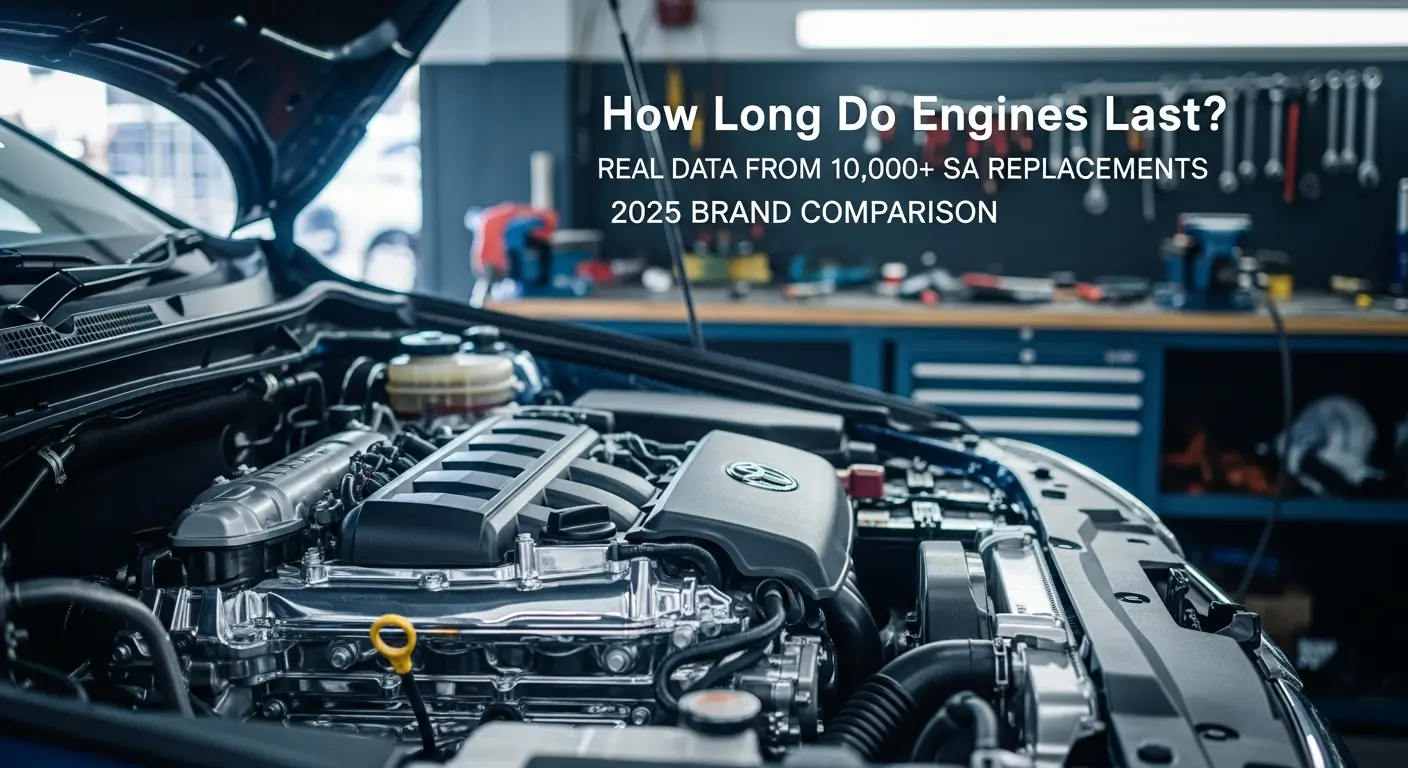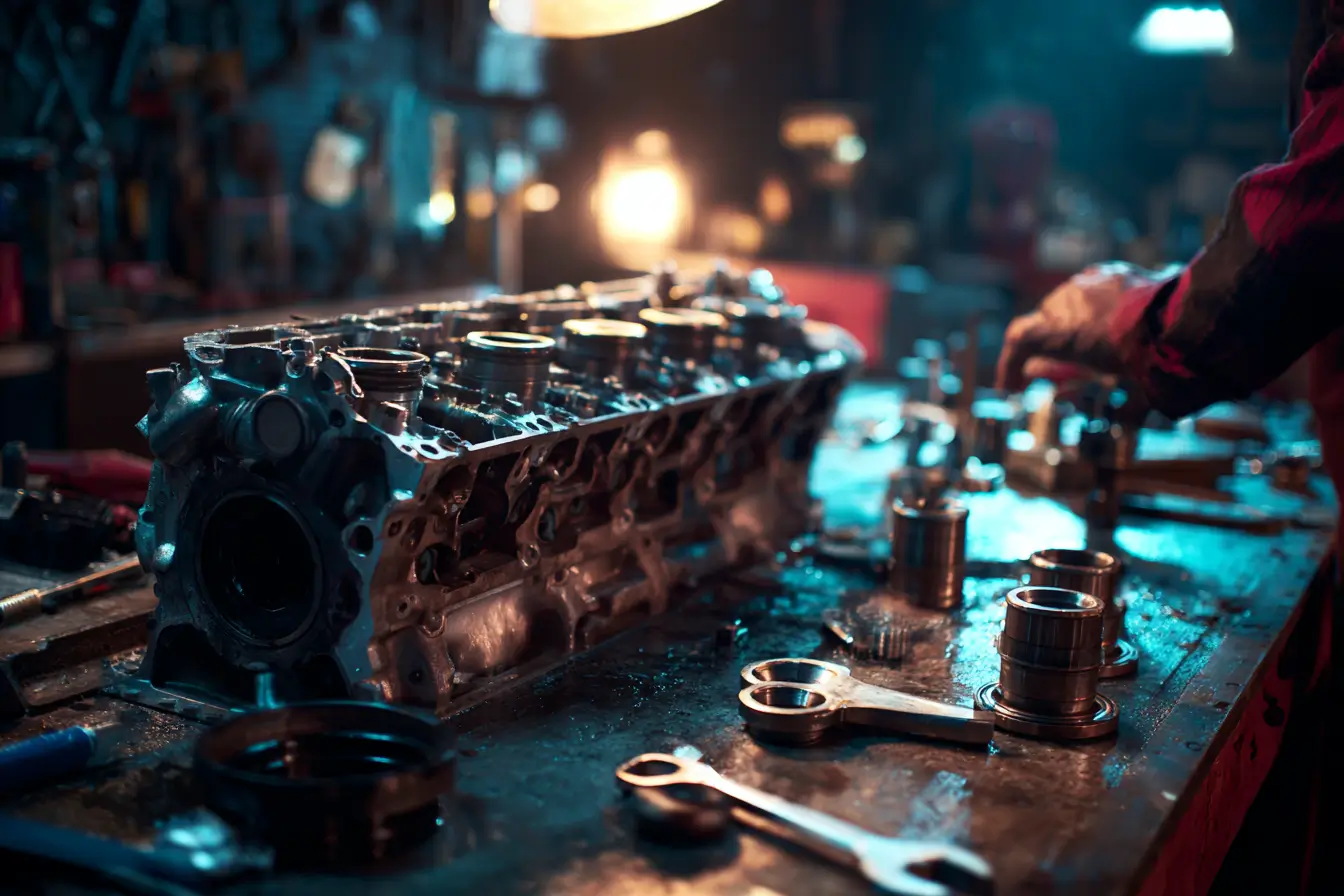
Diagnosing Starter Motor Problems: Complete Troubleshooting Guide
Key Takeaways
| Problem | Main Symptoms | Possible Causes |
|---|---|---|
| Dead Starter Motor | Engine won’t crank, clicking sound | Worn motor brushes, faulty solenoid |
| Slow Cranking | Engine turns over slowly | Weak battery, corroded connections |
| Grinding Noise | Grinding when starting | Worn flywheel ring gear, bendix drive |
| Intermittent Starting | Sometimes starts, sometimes doesn’t | Loose connections, worn contacts |
| Starter Stays Engaged | Starter runs continuously | Stuck solenoid, damaged bendix |
| No Response | Nothing happens when turning key | Bad ignition switch, blown fuse |
🔧 Equipment Needed: Multimeter, socket set, wire brush, jump leads
💰 Diagnostic Cost: R350-R650 for professional diagnosis
⏱️ Repair Time: 2-4 hours for replacement
Overview
The starter motor is a crucial electrical component that converts battery power into mechanical energy to crank your engine and initiate combustion. Understanding how to diagnose starter motor problems can save time, money, and prevent roadside breakdowns across South African driving conditions.
Starter Motor System Specifications
| Specification | Details |
|---|---|
| Voltage | 12V DC standard automotive system |
| Current Draw | 150-400 amps during cranking |
| Torque Output | 15-25 ft-lbs typical |
| Engagement Method | Solenoid-activated bendix drive |
| Service Life | 100,000-150,000 km typical |
| Common Types | Gear reduction, direct drive |
| Testing Voltage | 9.6V minimum during crank |
| Applications | All petrol and diesel vehicles |
Equipment Needed for Starter Diagnostics
- Digital Multimeter: For voltage and continuity testing (R200-R500)
- Socket Set: For starter removal and installation (R300-R800)
- Wire Brush: For cleaning terminals and connections (R25-R50)
- Jump Leads: For bypass testing (R150-R400)
- Basic Tools: Screwdrivers, wrenches (R200-R500)
- Work Light: For visibility under vehicle (R100-R300)
1. Dead Starter Motor
Causes
- Worn carbon brushes in motor
- Faulty starter solenoid
- Burned out armature windings
- Seized starter motor bearings
- Corroded internal components
Symptoms
- Single click when turning key
- Engine completely fails to crank
- Lights dim when attempting to start
- No sound at all from starter area
- Dashboard lights work normally
Solution
- Test starter motor with multimeter
- Check solenoid operation with bypass test
- Replace worn carbon brushes if accessible
- Professional starter motor rebuild
- Complete starter motor replacement
DIY Difficulty / Hours
- Electrical testing: Easy / 0.5-1 hour
- Brush replacement: Moderate / 1-2 hours
- Starter replacement: Moderate / 2-4 hours
- Professional replacement: R1,200-R3,500
Diagnostic Tip
Before replacing the starter, perform a “hammer test” by gently tapping the starter housing while someone turns the key. If the engine starts, the starter motor brushes are likely worn.
2. Slow Cranking
Causes
- Weak or old battery
- Corroded battery terminals
- Loose starter connections
- Thick engine oil in cold weather
- Partial starter motor failure
Symptoms
- Engine turns over very slowly
- Takes multiple attempts to start
- Cranking speed decreases over time
- Headlights dim significantly during cranking
- More noticeable in cold weather
Solution
- Test battery voltage and load capacity
- Clean and tighten all connections
- Check starter current draw with amp clamp
- Replace battery if below 12.4V at rest
- Service starter motor if current draw excessive
DIY Difficulty / Hours
- Battery testing: Easy / 0.5 hour
- Terminal cleaning: Easy / 0.5 hour
- Connection tightening: Easy / 0.5 hour
- Battery replacement: Easy / 1 hour
3. Grinding Noise
Causes
- Worn flywheel ring gear teeth
- Damaged starter bendix drive
- Incorrect starter motor mounting
- Worn starter drive pinion
- Flywheel misalignment
Symptoms
- Grinding sound during cranking
- Metallic scraping noise
- Difficulty engaging with flywheel
- Sporadic starting success
- Noise continues briefly after engine starts
Solution
- Inspect flywheel ring gear for damage
- Replace starter bendix drive assembly
- Check starter motor mounting alignment
- Machine or replace flywheel if severely worn
- Professional flywheel and starter inspection
DIY Difficulty / Hours
- Visual inspection: Easy / 0.5 hour
- Bendix replacement: Difficult / 3-5 hours
- Flywheel service: Professional / R2,500-R6,000
- Complete repair: R1,800-R8,000
Grinding Warning
Never continue attempting to start if you hear grinding noises. This can cause severe flywheel damage, resulting in expensive transmission or engine removal for repairs.
4. Intermittent Starting
Causes
- Loose electrical connections
- Worn starter solenoid contacts
- Heat-related expansion issues
- Corroded ground connections
- Faulty ignition switch
Symptoms
- Sometimes starts normally, sometimes doesn’t
- Problem worsens when engine is hot
- Jiggling key sometimes helps
- Works after sitting for a while
- Pattern seems random
Solution
- Clean and secure all electrical connections
- Test ignition switch operation
- Check starter solenoid contacts
- Verify proper ground connections
- Replace intermittent components
DIY Difficulty / Hours
- Connection inspection: Easy / 1 hour
- Ignition switch testing: Moderate / 1-2 hours
- Solenoid replacement: Moderate / 1-3 hours
- Professional diagnosis: R350-R650
5. Starter Stays Engaged
Causes
- Stuck starter solenoid
- Damaged bendix drive spring
- Faulty ignition switch
- Shorted starter relay
- Mechanical bindng in drive assembly
Symptoms
- Starter continues running after engine starts
- High-pitched whining noise
- Burning smell from starter area
- Engine starts but starter won’t disengage
- Potential starter motor damage
Solution
- Immediately turn off ignition and disconnect battery
- Replace faulty starter solenoid
- Check ignition switch operation
- Replace starter relay if defective
- Professional starter drive assembly service
DIY Difficulty / Hours
- Emergency disconnect: Easy / 0.1 hour
- Relay replacement: Easy / 0.5 hour
- Solenoid replacement: Moderate / 1-2 hours
- Professional repair: R800-R2,500
6. No Response
Causes
- Blown starter fuse or relay
- Bad ignition switch
- Faulty neutral safety switch
- Broken wiring in starter circuit
- Dead battery
Symptoms
- Absolutely nothing happens when turning key
- No clicking, no lights dimming
- All other electrical systems work normally
- Engine immobilizer may be active
- Complete electrical silence
Solution
- Check and replace starter fuse/relay
- Test ignition switch continuity
- Verify neutral safety switch operation
- Trace and repair broken wiring
- Test battery condition thoroughly
DIY Difficulty / Hours
- Fuse/relay check: Easy / 0.5 hour
- Switch testing: Moderate / 1-2 hours
- Wiring diagnosis: Difficult / 2-4 hours
- Professional electrical diagnosis: R450-R850
Step-by-Step Diagnostic Process
- Safety First: Park on level ground, engage parking brake, wear safety glasses
- Battery Test: Check voltage (12.4V+ at rest), load test if needed
- Visual Inspection: Look for obvious damage, corrosion, loose connections
- Connection Test: Clean and tighten all battery and starter connections
- Fuse/Relay Check: Verify starter circuit fuses and relays
- Voltage Drop Test: Test for excessive resistance in starter circuit
- Starter Amperage: Measure current draw during cranking (should be 150-400 amps)
Professional Automotive Services
Starter Motor Diagnostic Services
- Basic Diagnosis: R350-R650 (1-2 hours)
- Advanced Electrical Testing: R450-R850 (2-3 hours)
- Complete System Analysis: R650-R1,200 (3-4 hours)
- Mobile Diagnostic Service: R550-R950 (additional callout fee)
Starter Motor Replacement Services
- Basic Starter Replacement: R800-R1,500 (labor only)
- Premium Starter Installation: R1,200-R2,500 (includes testing)
- Fleet Vehicle Service: R750-R1,300 per vehicle
- Emergency Roadside Service: R1,500-R3,000 (includes callout)
Video Guides
How to Diagnose and Replace a Starter - ChrisFix
This comprehensive guide from ChrisFix shows step-by-step starter motor diagnosis using basic tools, making it perfect for DIY mechanics in South Africa.
Diagnosing Starter Problems - EricTheCarGuy
EricTheCarGuy provides professional diagnostic techniques and troubleshooting methods used by automotive technicians worldwide.
Preventative Maintenance Tips
Regular Service Schedule
| Service Type | Interval | Components |
|---|---|---|
| Battery Testing | Every 6 months | Voltage, load capacity, terminals |
| Connection Cleaning | Every 12 months | Battery, starter, ground connections |
| Starter Testing | Every 24 months | Current draw, voltage drop testing |
| Electrical Inspection | Every 36 months | Wiring, fuses, relays, switches |
| Complete Service | Every 60,000 km | Full electrical system diagnosis |
Critical Maintenance Items
- Keep Battery Charged: Weak batteries stress starter motors
- Clean Connections: Corrosion increases resistance and heat
- Quality Oil: Proper viscosity reduces cranking load
- Regular Starts: Don’t let vehicle sit unused for months
- Professional Testing: Annual electrical system checks
FAQ
How do I know if it’s the starter motor or battery?
If dashboard lights work but engine won’t crank, it’s likely the starter. If no lights work, test the battery first. A voltmeter reading below 12.4V indicates battery problems.
Can I jump-start a car with a bad starter?
Jump-starting won’t help if the starter motor itself is faulty. It only helps if the battery is too weak to provide sufficient power to a working starter.
Is it safe to hit the starter with a hammer?
Gentle tapping can sometimes free stuck brushes temporarily, but this is not a permanent fix and may cause damage. Replace the starter instead.
How long do starter motors typically last?
Most starter motors last 100,000-150,000 km with proper maintenance. City driving with frequent starts reduces lifespan compared to highway driving.
What causes starter motors to fail prematurely?
Weak batteries, corroded connections, and extended cranking periods are the main causes. Heat from engine bay conditions also accelerates wear.
Can I rebuild my own starter motor?
Starter rebuilding requires specialized tools and expertise. Most DIY mechanics should replace rather than rebuild starter motors.
Conclusion
Proper starter motor diagnosis requires systematic testing and understanding of the electrical system. Regular maintenance, quality connections, and prompt attention to warning signs can prevent most starter failures and avoid inconvenient breakdowns.
When starter motor replacement becomes necessary, Engine Finder provides access to quality used engines for sale and professional automotive services across South Africa.
References and Further Reading
Technical Resources
Diagnostic Tools
Community Resources
Related Articles
Explore more insights on similar topics

How Long Do Engines Last on Average? Complete Longevity Guide
Understand real-world engine lifespan ranges, warning signs, lifecycle stages, costs, and maintenance best practices for South African drivers.

How Does an Engine Overhaul Work? Complete Guide to Engine Rebuilds
Learn everything about engine overhauls: types, warning signs, process, costs, and when to rebuild vs replace your engine in South Africa.
.webp)
Timing Chain vs Timing Belt: Complete Guide to Cambelt Replacement & Lifespan
Learn everything about timing chains and timing belts (cambelts): differences, lifespans, replacement costs, and which is better for your engine in South Africa.
Important Disclaimer
This content is for informational purposes only and is based on research from automotive industry sources. Engine Finder is not a certified automotive repair facility. Always consult with qualified automotive professionals before performing any repairs or maintenance. Improper repairs can result in personal injury, property damage, or vehicle malfunction. We assume no responsibility for actions taken based on this information.
